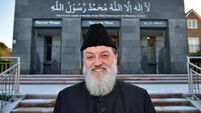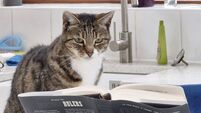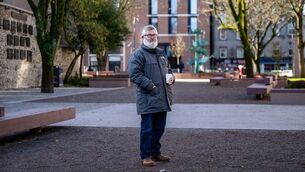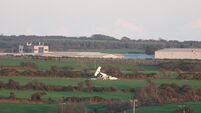Michael Moynihan: Grave concern over brainless acts at Kilcrea Friary

Matthew Seaver, National Museum of Ireland assistant keeper at the Irish Antiquities Division, recording the disturbed ground at Kilcrea Friary, Ovens, Cork. Picture: Jim Coughlan
I know my beat, don’t worry. I tend not to stray from the mean streets.
In that sense, I warm to the old New York boxing trainer who gave this warmish endorsement of an alien environment when he returned to the city from remoter parts: ‘I love the country. It’s a great place to visit.’
But I’m afraid I have to look beyond the city boundaries this morning, because last week Eoin English of this parish reported on a disturbing development outside the city, and ‘disturbing’ is the operative term. It appears that some people out by Ovens to the west and Fermoy to the east have been — how to put this politely? — acting the ghoul, and I use that description in the Burke and Hare sense of the word.
“Experts from the National Museum of Ireland, the National Monuments Service, and the Office of Public Works (OPW) spent Thursday assessing the damage to Ireland’s archaeological heritage following the most recent incident involving illegal metal-detector use at Kilcrea Friary in Ovens, west of Cork city,” Eoin wrote.
“They identified at least ten holes which were dug by detectorists at the protected national monument, a ruined medieval abbey built by Franciscans in the mid-15th century and occupied until the early 1600s. Its burial ground contains the remains of Art Ó Laoghaire, the subject of the epic poem written by Eibhlín Dubh Ní Chonaill.”
So much to discuss. So much revealed.
First, there’s something apt about this report appearing in the paper on St Patrick’s Day, itself an encapsulation of nationality.
This kind of brainless solipsism is characteristic of the modern age in Ireland, the era in which my personal tastes take precedence over everything and supersede without question any consideration of others
Consider it an overpowering national characteristic at this point, one illustrated also by the marble-headed ignorance of those people who need to fly their drones in the one part of the country where they’re specifically asked not to.
Or the generous souls keen to share their drugs with you whether you want them or not.
Or share their phone calls with you. Or their music choice.
It’s their world. You just appear in it as a matter of local colour.
Second, the appearance of Art Ó Laoghaire in this story adds a fine glaze of irony to the whole enterprise. There were similar incidents at Conna Castle near Fermoy in east Cork, incidents which are no less serious, but the Art Ó Laoghaire factor sets Kilcrea Abbey apart. That’s because the grave-robbers heading for Kilcrea are obviously doing so in the hopes of unearthing something of value, a beautiful object they could offload on eBay for a few bob.
Of course, there’s something stunning, something priceless, in the graveyard already. It’s just they can’t sell it, because it’s notional
That’s the memory of Art Ó Laoghaire, which has never faded because of the poem written by his wife to commemorate him.
Caoineadh Art Ui Laoghaire is one of the most beautiful poems ever written in Ireland, in either English or Irish. It has survived for centuries, been translated by both Frank O’Connor and Thomas Kinsella. It was quoted by Hunter S Thompson, and was recently transformed all over again by Doireann Ni Bhriain in her book, A Ghost In The Throat.
(When it was made into an Irish-language film back in the seventies the role of Art was taken by Seán Bán Breathnach, casting that is simultaneously left-field and completely appropriate.)
There is no suggestion that the remains of Art Ó Laoghaire were disturbed by the people who decided to rummage around Kilcrea graveyard. If they had done so it would have been over-determined, too heavy-handed a move — a novelist would be scolded for inventing it, particularly when Eibhlín Dubh Ní Chonaill wrote the following:
Mo ghrá thu go daingean!
is éirigh suas id’ sheasamh
is tar liom féin abhaile,
(My steadfast love!
Arise, stand up
and come home with myself).
She was hardly thinking then that a couple of hundred years later there’d be people seeking to do just that with the bones of those lying near her husband, but that’s how it played out. There were human remains disturbed by the actions of these clowns.
When those people were laid to rest by their loved ones it was with the reasonable expectation that ‘rest’ would not just be a word carved on a headstone, but would be a feature of their tenure
Not so, apparently, as some people’s ‘hobby’ must be facilitated at the expense of the dignity of others.
It would be interesting to see what would happen if these people decided to climb into the Huguenot Graveyard on French Church Street with their . . . equipment, and decided to start rooting and digging and pulling and dragging. It’s exactly the same situation as Kilcrea and Conna, just in the middle of the city.
Or — a far better example — what if these characters decided to head out to St Finbarr’s Cemetery in Glasheen to have a poke around?
The difference in the latter case, in particular, is that some readers may have loved ones interred in St Finbarr’s; if so, you would probably not be too kindly disposed towards someone pursuing their hobby at the expense of your family members’ last resting place.
Yet this is exactly what happened recently out in Kilcrea and Conna, and the activities were not designed to add to the storehouse of human knowledge.
“People don’t like it and people are upset by it. It affects the visitor experience,” Anne Carey, the district archaeologist in the National Monuments Service, told Eoin English.
“It’s usually for the purposes of finding metal, but metal is just one of the aspects of the rich range of remains left by previous occupants of a site.”
Don’t forget: it’s illegal to use a metal detector at a protected national monument site. It’s also illegal to be in possession of such a device at those sites without prior ministerial approval, and the penalties include fines of up to €63,486 or three months in jail.
One of the few bright spots in this shabby tale is the fact that in the recent spate of cases in Cork, it was the public which intervened (anyone who spots people messing like this at a national monument site is urged to contact nationalmonuments@housing.gov.ie where the reports will be investigated.)
It’s heartening to learn that in these cases that’s exactly what happened — in both Kilcrea and Conna, these people were seen at their work and the authorities were alerted. I think there may be a sense abroad that such people are essentially harmless, due in no small part to the amiable, shambling image projected by the TV comedy Detectorists, which shows the practitioners, a couple of bickering pals, in an essentially affectionate light. If that description fits their Irish equivalents, fair enough. Just leave Art Ó Laoghaire and the lads alone.

Unlimited access. Half the price.
Try unlimited access from only €1.50 a week
Already a subscriber? Sign in
CONNECT WITH US TODAY
Be the first to know the latest news and updates











